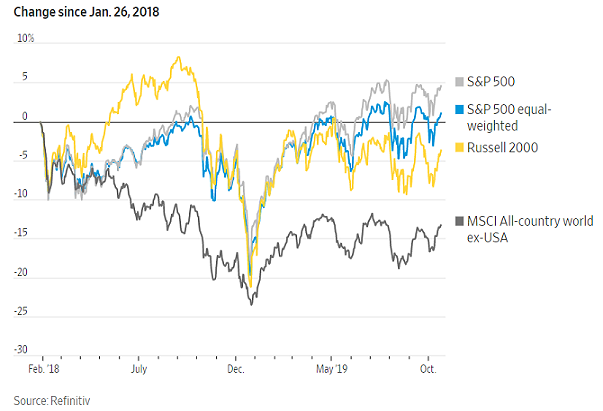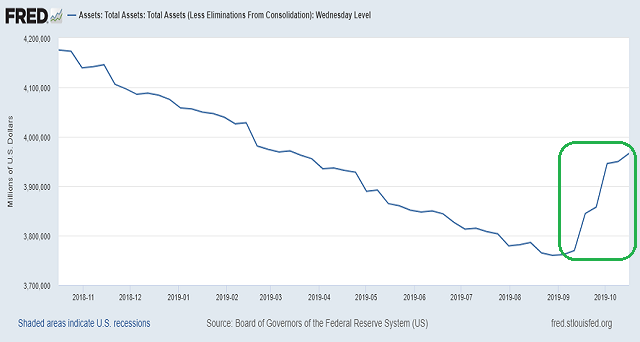Can you force credit on those who are not necessarily asking for it? Even at ultra-low rates?

Consider homebuyers. Mortgage rates are dramatically lower than they were a year ago. Regardless, the median new home sales price has had to drop significantly to entice fresh borrowing.
At some point, consumers and businesses may choose to avoid more debt altogether. It simply won’t matter how cheap the cost of capital becomes. (That’s what transpires during a recession.)

In truth, we’ve already seen the ill-effects of negative rate policy in Europe and Japan. Ex U.S. businesses have not taken the bait. The unwillingness of ex U.S. companies to borrow in the debt markets for the purpose of buying back stock shares partially explains why a global bear has persisted since January of 2018.
Since January 2018, ex U.S. stocks have yet to recover and remain down more than 10% from highs. Meanwhile, even small stocks in the U.S. Russell 2000 Index are negative over one year and nine months.
Granted, the S&P 500 may have gained close to 5% in a market-cap weighted capacity. Nevertheless, one would have done better over the past 21 months with 100% in “risk-free” intermediate-term U.S. Treasuries via iShares 7-10 Year Treasury Bond (NYSE:IEF).
From an individual sector standpoint, U.S. financials, industrials, materials and energy are negative since January 2018 as well. That has a lot to do with the worldwide manufacturing slowdown.
“But Gary,” some say. “U.S. stocks have been remarkably resilient, and they’re poised to break out to all-time record highs.” Maybe.
Naturally, stocks could pop on trade deals. For that matter, economic growth around the world could make a comeback. Yet this remains in the category of “hope,” and it certainly does not constitute an investment strategy.
On the flip side, just how much Federal Reserve manipulation has been necessary to avoid a wealth effect reversal? First, we went from rate hikes to rate neutrality at the start of 2019, augmented by an end date on quantitative tightening (QT). Less than six months later, Jerome Powell, chairman of the Fed, began promising rate cuts.
Not only did we get rate cut 1, and rate cut 2. We’re getting a third one here in October.
But wait. There’s more. The Fed started a massive QE4 program to acquire treasury bills so that more liquidity would end up in risk assets.

Talk about monetary policy stimulus! The Fed has increased its balance sheet by $200 billion in the last month alone!
It’s not difficult to see why financial assets of all stripes are hanging in there. “Money” continues to make its way into risk.
What is more difficult to see is the other side of this equation. Specifically, with everything from trillions in government deficit spending to corporate stock buybacks to mountainous levels of Fed stimulus, why has the U.S. stock market barely made progress since January of 2018?
The answer may not be as straightforward as one would like. Recession fears. Political uncertainty. Geopolitical strife.
That said, those who I speak with in and around “Wall Street” currently fret about the strong prospect of an Elizabeth Warren agenda. What’s more, scores of candidates on the Democrat side of the aisle openly discuss unraveling Trump administration policies, from deregulation to corporate tax cuts.
In other words, monetary policy may be a phenomenal driver for asset prices. But the threat of monumental changes at the fiscal level could be a straw that breaks the asset camel’s back. (Note: This is not political commentary, but rather, a discussion of “possible” stock and bond market ramifications.)
Nobody knows who will control the U.S. Congress. Or for that matter, who will will win the presidential election in 2020.
Still, I am willing to make a relatively bold prediction. With the Fed’s increasingly aggressive intentions, alongside recessionary concerns and an uncertain election, the U.S. 10-year yield will fall below 1%.
75 basis points and a modicum of yield might not seem like it will produce an extraordinary total return. Maybe we are talking about 5%-7% on iShares 7-10 Year Treasuries (IEF).
Then again, I do not have the same confidence that, prior to the outcome of the 2020 decision(s), U.S. stocks will hold at levels that are 5%-10% higher than they are today. Even if they go up 10% to close out to 2019, they’d likely be reined back in before October 24th of 2020.
It is true that Federal Reserve QE has been incredible in boosting risk assets in the past. However, I am not a believer in the notion that the Fed has repealed the business cycle. As I wrote earlier, there comes a time when the Fed won’t be able to force credit on those who choose to refuse it.
Disclosure: Gary Gordon, MS, CFP is the president of Pacific Park Financial, Inc., a Registered Investment Adviser with the SEC. Gary Gordon, Pacific Park Financial, Inc, and/or its clients June hold positions in the ETFs, mutual funds, and/or any investment asset mentioned above. The commentary does not constitute individualized investment advice. The opinions offered herein are not personalized recommendations to buy, sell or hold securities. At times, issuers of exchange-traded products compensate Pacific Park Financial, Inc. or its subsidiaries for advertising at the ETF Expert web site. ETF Expert content is created independently of any advertising relationships.
